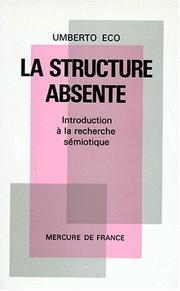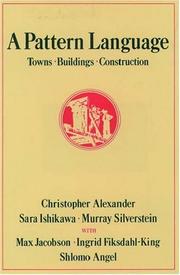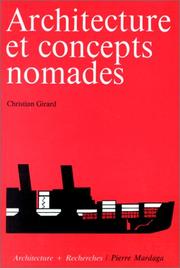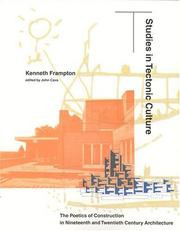| Listing 1 - 10 of 26 | << page >> |
Sort by
|
Book
ISBN: 9780262047746 Year: 2023 Publisher: Cambridge ; London : The MIT Press,
Abstract | Keywords | Export | Availability | Bookmark
 Loading...
Loading...Choose an application
- Reference Manager
- EndNote
- RefWorks (Direct export to RefWorks)
How modern architectural language was invented to communicate with the divine—challenging a common narrative of European architectural history. The architectural drawing might seem to be a quintessentially modern form, and indeed many histories of the genre begin in the early modern period with Italian Renaissance architects such as Alberti. Yet the Middle Ages also had a remarkably sophisticated way of drawing and writing about architecture. God's Own Language takes us to twelfth-century Paris, where a Scottish monk named Richard of Saint Victor, along with his mentor Hugh, developed an innovative visual and textual architectural language. In the process, he devised techniques and terms that we still use today, from sectional elevations to the word “plan.” Surprisingly, however, Richard's detailed drawings appeared not in an architectural treatise but in a widely circulated set of biblical commentaries. Seeing architecture as a way of communicating with the divine, Richard drew plans and elevations for such biblical constructions as Noah's ark and the temple envisioned by the prophet Ezekiel. Interpreting Richard and Hugh's drawings and writings within the context of the thriving theological and intellectual cultures of medieval Paris, Karl Kinsella argues that the popularity of these works suggests that, centuries before the Renaissance, there was a large circle of readers with a highly developed understanding of geometry and the visual language of architecture.
Architectural drawing --- Architecture and religion. --- Symbolism in architecture. --- History --- Richard, --- Dessin d'architecture --- Architecture et religion --- Symbolisme en architecture --- Histoire
Book
ISBN: 0253051169 Year: 1979 Publisher: Indiana University Press
Abstract | Keywords | Export | Availability | Bookmark
 Loading...
Loading...Choose an application
- Reference Manager
- EndNote
- RefWorks (Direct export to RefWorks)
The Semiotics of Built Environment provides an introduction to architectonic analysis, described in the author's preface to the 1979 edition as follows: "This book is concerned with the analysis and description of the built environment as a semiotic system—as a system of meaningful signs. It seeks to establish some of the principal ways in which what will be termed architectonic systems are similar to and different from other forms of human symbolic communication."
Symbolism in architecture. --- Semiotics. --- Semiotique. --- Symbolisme en architecture. --- Architectural symbolism --- Signs and symbols in architecture --- Architecture --- Semeiotics --- Semiology (Linguistics) --- Semantics --- Signs and symbols --- Structuralism (Literary analysis) --- Literary theory

ISBN: 2715201850 9782715201859 Year: 1984 Publisher: Paris : Mercure de France,
Abstract | Keywords | Export | Availability | Bookmark
 Loading...
Loading...Choose an application
- Reference Manager
- EndNote
- RefWorks (Direct export to RefWorks)
General semantics --- Semantics (Philosophy) --- Semiotics --- Sémantique générale --- Sémantique (Philosophie) --- Sémiotique --- Umberto Eco ; traduit de l'italien par Uccio Esposito-Torrigiani --- Eco Umberto --- semiotiek --- narratologie --- taal --- taalfilosofie --- 003 --- Sémantique générale --- Sémantique (Philosophie) --- Sémiotique --- Sémiotique et art. --- Symbolisme en architecture. --- Sémantique (philosophie) --- Communication visuelle. --- Structuralisme (architecture) --- Sémiotique et art. --- Symbolisme en architecture --- Sémantique (philosophie) --- Communication visuelle

ISBN: 0195019199 9780195019193 9780199726530 0199726531 0190050357 9780199726530 9780190050351 Year: 1979 Volume: 2 Publisher: New York, N.Y.: Oxford university press,
Abstract | Keywords | Export | Availability | Bookmark
 Loading...
Loading...Choose an application
- Reference Manager
- EndNote
- RefWorks (Direct export to RefWorks)
You can use this book to design a house for yourself with your family; you can use it to work with your neighbors to improve your town and neighborhood; you can use it to design an office, or a workshop, or a public building. And you can use it to guide you in the actual process of construction. After a ten-year silence, Christopher Alexander and his colleagues at the Center for Environmental Structure are now publishing a major statement in the form of three books which will, in their words, "lay the basis for an entirely new approach to architecture, building and planning, which will we hope replace existing ideas and practices entirely." The three books are The Timeless Way of Building, The Oregon Experiment, and this book, A Pattern Language. At the core of these books is the idea that people should design for themselves their own houses, streets, and communities. This idea may be radical (it implies a radical transformation of the architectural profession) but it comes simply from the observation that most of the wonderful places of the world were not made by architects but by the people. At the core of the books, too, is the point that in designing their environments people always rely on certain "languages," which, like the languages we speak, allow them to articulate and communicate an infinite variety of designs within a forma system which gives them coherence. This book provides a language of this kind. It will enable a person to make a design for almost any kind of building, or any part of the built environment. "Patterns," the units of this language, are answers to design problems (How high should a window sill be? How many stories should a building have? How much space in a neighborhood should be devoted to grass and trees?). More than 250 of the patterns in this pattern language are given: each consists of a problem statement, a discussion of the problem with an illustration, and a solution. As the authors say in their introduction, many of the patterns are archetypal, so deeply rooted in the nature of things that it seemly likely that they will be a part of human nature, and human action, as much in five hundred years as they are today.
Symbolism in architecture --- Semiotics --- patroonbeschrijving --- Symbolisme en architecture --- Sémiotique --- Architecture --- Terminologie --- architectuur --- Building design --- Environmental planning --- architectural theory --- architectuurtheorie --- architecture [discipline] --- patroonherkenning --- Symbolism in architecture. --- Semiotics. --- Sémiotique --- Terminology --- Symbolisme en architecture. --- Sémiotique. --- Terminologie. --- Sémiotique. --- Harmony (Aesthetics) --- Architectural design. --- Human factors.
Book
ISBN: 0856708607 9780856708602 Year: 1985 Publisher: London
Abstract | Keywords | Export | Availability | Bookmark
 Loading...
Loading...Choose an application
- Reference Manager
- EndNote
- RefWorks (Direct export to RefWorks)
Private houses --- Architecture --- Symbolism in architecture --- Interior architecture --- Architecture, Domestic --- Symbolisme en architecture --- Architecture intérieure --- Architecture domestique --- Philosophy --- History --- Philosophie --- Histoire --- 72.036 --- Architectuur ; symbolische ; het thematische huis --- Woningbouw ; 20ste eeuw ; Postmodernisme --- 72.04 --- 72.038 --- architectuur --- twintigste eeuw --- woningen --- interieurvormgeving --- Jencks Charles --- 20ste eeuw (architectuur) --- Twintigste eeuw (architectuur) --- Architectuur ; details, ornamenten, decoratie --- Architectuurgeschiedenis ; 1950 - 2000 --- Symbolism in architecture. --- Symbolisme en architecture. --- Arquitetura Pos-Moderna. --- Symbol. --- Postmoderne. --- Architektur. --- Philosophy. --- Philosophie. --- Jencks, Charles --- Contributions in postmodern architecture. --- Et l'architecture postmoderne. --- Architecture intérieure
Book
ISBN: 9782884746434 2884746439 Year: 2013 Publisher: Paris Infolio éditions
Abstract | Keywords | Export | Availability | Bookmark
 Loading...
Loading...Choose an application
- Reference Manager
- EndNote
- RefWorks (Direct export to RefWorks)
Dans cet ouvrage, l'auteur distingue en premier ce qu'est l'architecture de la simple construction afin de montrer comment la théorie s'avère centrale dans la démarche architecturale. Il introduit ainsi la notion de "lieu", d'abord en tant que problème philosophique, puis en tant qu'aspect d'une "édification" et finalement en tant que phénomène architectural et territorial (la notion de paysage, par exemple). Développant cette réflexion qui repose sur plus de vingt années de recherches dans le domaine de la sémiotique des lieux, l'auteur met en place un dispositif cognitif mobilisant de nombreux diagrammes et figures répondant à ce qu'est l'architecture en général (qu'elle soit simple pavillon d'exposition de sculptures, avec Aldo van Eyck, ou recomposition urbaine de la ville, avec Louis Kahn). En conclusion, l'auteur aborde la question iconologique de cette problématique en reconsidérant la démarche d'Aloïs Riegl à propos de l'ornement comme moyen terme entre une science et un art.
Architecture --- Place (Philosophy) --- Semiotics and architecture --- Lieu (Philosophie) --- Sémiotique et architecture --- Philosophy. --- Philosophie --- Sémiologie --- Espace architectural --- Philosophy --- Symbolisme en architecture --- Sémiotique et art --- Lieu (philosophie) --- Perception spatiale --- 72.01 --- Architectuurtheorie ; architectuurfilosofie ; 21ste eeuw --- Architecturale en stedenbouwkundige ruimte ; analyse --- Architectuur ; theorie, filosofie, esthetica --- Sémiotique et architecture --- Symbolisme en architecture. --- Sémiotique et art. --- Sémiotique et architecture. --- Perception spatiale. --- Philosophie. --- Architecture and semiotics --- Architecture - Philosophy --- Sémiotique et art. --- Architecture -- Philosophie
Book
ISBN: 3110543923 3110544318 9783110544312 9783110543926 9783110538809 3110538806 Year: 2018 Publisher: Berlin ; Boston : De Gruyter,
Abstract | Keywords | Export | Availability | Bookmark
 Loading...
Loading...Choose an application
- Reference Manager
- EndNote
- RefWorks (Direct export to RefWorks)
Die Ausstattung repräsentativer Tempel- und Schatzhausarchitektur mit Bauskulpturen ist ein Phänomen, das vom 6. bis zum 4. Jahrhundert v. Chr. in Griechenland vielfältig anzutreffen ist. Die Akrotere auf dem Dach waren durch ihre Position besonders auffällig im Erscheinungsbild eines Gebäudes und nahmen damit entscheidenden Einfluss auf seine Wahrnehmung im Kontext des Heiligtums. Die vorliegende Arbeit untersucht die ästhetische und bildliche Konzeption von figürlichen Akroterbildern sowie ihre Wirkung in engem Zusammenhang zu ihrem architektonischen und historischen Kontext. Im Mittelpunkt steht demnach die Frage danach, was diese Bilder für das Gebäude und seine Auftraggeber leisteten. Gleichzeitig werden als Grundlage für diese Fragen auch die Dächer in den Blick genommen, die etwa Auskunft darüber geben, wie Akrotere befestigt und wie sie genau positioniert wurden. Die verschiedenen Konzepte der Akroterbilder und die Umstände ihrer Verwendung geben Einblick in die Potenziale eines Bildfeldes in der griechischen Architektur, das einerseits für die ästhetische Gestaltung und Charakterisierung des Gebäudes, andererseits auch für die Repräsentation der Auftraggeber einen entscheidenden Beitrag leistete.
Acroteria. --- Figure sculpture, Greek. --- Symbolism in architecture --- Akrotere. --- Akroteria. --- Bauskulptur. --- Greek architecture / roofs. --- Greek architecture. --- architectural sculpture. --- griechische Architektur /Dächer. --- griechische Architektur. --- Architectural symbolism --- Signs and symbols in architecture --- Architecture --- Greek figure sculpture --- Pediments --- Details --- Architecture, Greek --- Acrotères --- Sculpture de figures humaines grecque --- Architecture grecque --- Symbolisme en architecture --- ART / History / Ancient & Classical.

ISBN: 2870092598 9782870092590 Year: 1986 Volume: 26 Publisher: Liège: Mardaga,
Abstract | Keywords | Export | Availability | Bookmark
 Loading...
Loading...Choose an application
- Reference Manager
- EndNote
- RefWorks (Direct export to RefWorks)
Architecture --- architectural theory --- architectuur --- architecture [discipline] --- Bouwkunst --- Symbolism in architecture. --- Symbolisme en architecture --- Philosophy. --- Philosophie --- Symbolism in architecture --- Architecturologie --- Epistémologie --- Théorie de l'architecture --- Philosophy --- Eisenman, Peter --- Gregotti, Vittorio --- Kahn, Louis Isidore --- Le Corbusier --- Traité d'architecture --- Esthétique --- Théorie --- -Symbolism in architecture --- Architectural symbolism --- Signs and symbols in architecture --- Architecture, Western (Western countries) --- Building design --- Buildings --- Construction --- Western architecture (Western countries) --- Art --- Building --- Design and construction --- -Symbolism in architecture. --- Kahn, Louis Isidore, --- Le Corbusier, --- Symbolisme en architecture. --- Esthétique. --- Philosophie. --- Le Corbusier, Charles-Edouard Jeanneret, --- Eisenman, Peter, --- CDL --- 72.01 --- Architecture - Philosophy --- Eisenman, Peter, 1932 --- -Gregotti, Vittorio --- Kahn, Louis Isidore, 1901-1974 --- Le Corbusier, Charles-Edouard Jeanneret, 1887-1965 --- Traité d'architecture --- Esthétique --- Théorie

ISBN: 9780262561495 9780262061735 0262561492 0262061732 Year: 1995 Publisher: Chicago (Ill.) : Graham foundation for advanced studies in the fine arts,
Abstract | Keywords | Export | Availability | Bookmark
 Loading...
Loading...Choose an application
- Reference Manager
- EndNote
- RefWorks (Direct export to RefWorks)
Historiographie de l'architecture du XXe siècle et des matériaux, techniques, procédés utilisés par les architectes dans l'optique d'une continuité entre la forme et la construction, le dessin et la réalisation.
Symbolism in architecture. --- Architecture, Modern --- Symbolisme en architecture --- Architecture --- Architecte --- Histoire de l'architecture --- Architectonique --- Scarpa, Carlo --- Utzon, Jorn --- Kahn, Louis Isidore, --- Mies Van Der Rohe, Ludwig --- Perret, Auguste, --- Wright, Frank Lloyd, --- Panorama mondial --- Mies Van Der Rohe, Ludwig, --- Sociology of environment --- architecture [discipline] --- Modern [style or period] --- anno 1800-1999 --- Architecture, Modern - 19th century. --- Architecture, Modern - 20th century. --- Kahn, Louis Isidore, 1901-1974 --- Mies Van Der Rohe, Ludwig, 1886-1969 --- Perret, Auguste, 1874-1954 --- Wright, Frank Lloyd, 1867-1959 --- Symbolism in architecture --- Architecture, Modern - 19th century --- Architecture, Modern - 20th century --- 72.01 --- Architectuur ; tekens en symbolen --- Architectuurtheorie ; architectuur ; 19de en 20ste eeuw --- Architectural symbolism --- Signs and symbols in architecture --- Architectuur ; theorie, filosofie, esthetica --- History --- 72.035 --- 72.036 --- 72.03 --- 19de eeuw (architectuur) --- Negentiende eeuw (architectuur) --- 20ste eeuw (architectuur) --- Twintigste eeuw (architectuur) --- Architectuur (geschiedenis) --- Architectuurgeschiedenis --- anno 1800-1899 --- anno 1900-1999 --- Symbolisme en architecture.
Book
ISBN: 2870090773 9782870090770 Year: 1997 Volume: vol *105 Publisher: Liège Pierre Mardaga
Abstract | Keywords | Export | Availability | Bookmark
 Loading...
Loading...Choose an application
- Reference Manager
- EndNote
- RefWorks (Direct export to RefWorks)
Dans ce brillant exposé, le professeur Norberg-Schulz propose une façon radicalement nouvelle de regarder l'architecture occidentale. Prenant comme prémisse l'utilisation de l'architecture par l'homme en tant que moyen symbolique pour apporter ordre et signification dans les relations entre lui-même et son environnement, il passe en revue toutes les époques principales de l'art occidental, de l'Egypte Ancienne à ce jour, examinant soigneusement les principales réalisations de la construction dans le contexte des implantations et des villes dans lesquelles elles ont été intégrées. Il en ressort que style et organisation ne sont pas de purs accidents historiques. Il montre que l'architecture de différentes périodes culturelles est, dans chaque cas, l'expression physique des croyances religieuses et philosophiques régnantes. En tant que tels, les bâtiments qui ont occupé des situations-clés dans la communauté - temples, églises, palais et lieux de réunions publiques - fournissent, par leur structure, la sécurité spirituelle essentielle à l'homme pour se sentir intégré dans ce monde. La maison privée aussi a reflété la conception en cours de l'homme, de sa place dans le temps et l'espace. Contre cet arrière-plan, "La signification dans l'architecture occidentale" apporte des aperçus précieux dans la crise où se trouve l'architecture contemporaine où la disparition de telles croyances est manifeste dans le manque d'unité des stèles de construction. Bien plus stimulant que l'exposé ordinaire, et richement illustré de 556 photographies, cartes et plans, "La signification dans l'architecture occidentale" offre une splendide introduction aux principaux développements de la construction et de l'urbanisation de l'Occident. Elle apporte également une contribution exceptionnelle à la fois à l'histoire d el'art et à la pensée existentielle appliquée.
Architecture --- Bouwkunst --- Symbolisme en architecture --- Architecture et histoire --- Facteurs humains --- Aspect social --- Teaching --- functionalism --- architectural theory --- Verlichting 1 --- architectonics --- Baroque --- Renaissance-Baroque architecture styles --- Mannerist [Renaissance-Baroque style] --- Renaissance --- Romanesque --- architecture [discipline] --- Gothic [Medieval] --- anno 1200-1499 --- anno 1300-1399 --- anno 1500-1599 --- anno 1100-1199 --- anno 1400-1499 --- anno 1000-1099 --- Rome --- Egypt --- Greece --- kunstfilosofie --- architectuur --- kunstgeschiedenis --- architectuurtekeningen --- philosophy of art --- architectural drawings [visual works] --- art history --- #TCBA --- #TCBA 72.01 Architectuuresthetica, -theorie --- Architectuurtheorie ; iconologie ; betekenis --- 72.01 --- Architectuur ; theorie, filosofie, esthetica --- Histoire de l'architecture --- Panorama mondial --- Architecture and society --- History. --- Symbolism in architecture --- Architecture et société --- Histoire --- Architectuur --- bouwtekeningen --- architectuur [vakgebied] --- architectuurtheorie --- Symbolisme en architecture. --- Architecture et histoire. --- Facteurs humains. --- Architectuur. --- architectuur [vakgebied]. --- architectuur. --- architectuurtekeningen. --- architectuurtheorie. --- bouwtekeningen. --- kunstfilosofie. --- kunstgeschiedenis. --- 710 --- symboles --- architecture --- bouwkunst
| Listing 1 - 10 of 26 | << page >> |
Sort by
|

 Search
Search Feedback
Feedback About UniCat
About UniCat  Help
Help News
News